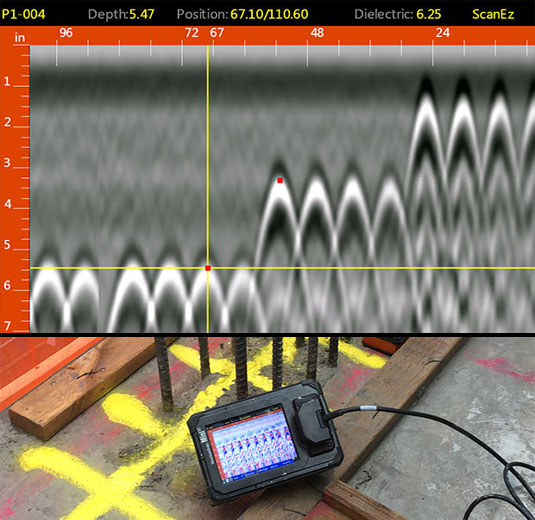RainierGPR Service Areas: Specialist Concrete Scanning in Your Region
RainierGPR Service Areas: Specialist Concrete Scanning in Your Region
Blog Article
Concrete Scanning: An Important Action Towards Making Sure Structural Honesty and Safety
In the world of building and facilities upkeep, the importance of concrete scanning can not be overemphasized. By utilizing innovative modern technology and methodologies, concrete scanning offers as a crucial device in making certain that the stability and safety of bridges and structures are supported to the highest possible standards.
Relevance of Concrete Scanning
Concrete scanning plays a critical role in making sure the architectural stability and safety and security of buildings and facilities projects. By making use of innovative modern technologies such as ground-penetrating radar (GPR) and electromagnetic induction, professionals can non-destructively inspect concrete structures to identify prospective issues, spaces, ingrained objects, and support layout. This procedure enables very early detection of anomalies that can compromise the security of a framework, avoiding costly damages and making sure the security of residents.
Prior to exploration, cutting, or coring right into concrete, scanning aids identify the exact areas of rebar, post-tension cables, and other embedded components, reducing the danger of unintentional hits that might lead to architectural weak points. Furthermore, concrete scanning help in quality control by validating the thickness of concrete covers and identifying any disparities that might affect the overall resilience of the framework.
Innovation for Concrete Evaluation

Benefits of Early Discovery
Prompt detection of architectural issues can significantly mitigate threats and make certain the longevity of building and construction projects. By determining possible problems early on in the building procedure, stakeholders can take proactive procedures to address issues before they rise right into bigger and more costly problems. One of the key benefits of very early detection is the prevention of structural failures, which can position severe safety and security hazards and lead to task delays and financial losses.
Moreover, very early detection enables prompt repair work and maintenance, which can help expand the life expectancy of the structure. By dealing with issues without delay, building and construction groups can prevent expensive repair work and even the need for premature substitute of architectural elements. This proactive approach not just conserves money and time yet likewise improves the overall security and durability of the construction project.
Furthermore, very early detection can boost project planning and decision-making by offering stakeholders with beneficial understandings right into the problem of the structure. Armed with this info, job managers can make informed options concerning building and construction techniques, products, and timelines, resulting in much more effective and effective project outcomes.
Ensuring Architectural Stability
Guaranteeing the structural stability of a construction project is critical to its safety and durability. Structural stability describes the ability of a structure or facilities to maintain its form and function under environmental problems and numerous lots. To achieve this, detailed assessment and tracking of the structure are essential. Concrete scanning plays a critical role in guaranteeing architectural security by spotting prospective problems such as spaces, delamination, or support deterioration that could compromise the stability of the framework in time.
By using advanced scanning technologies like ground-penetrating radar (GPR) and electro-magnetic induction, building and construction specialists can non-invasively inspect concrete structures to identify areas of worry below the surface area. This aggressive strategy enables the very early discovery of weak points or defects, enabling punctual repair services or visit this website reinforcement to protect against architectural failings.
Regular concrete scanning throughout various construction phases and throughout the life process of a structure can help keep its stability, mitigate threats, and make sure the safety and security of occupants. By prioritizing architectural stability through concrete scanning, construction tasks can improve their resilience and toughness, eventually contributing to better security and longevity.
Protecting Against Critical Failings
To secure versus tragic occasions, thorough tracking and aggressive upkeep are important in avoiding vital failings within structural frameworks. Finding potential issues you can try this out prior to they escalate is key to stop architectural failures. Executing regular assessments, such as concrete scanning, can reveal hidden issues like spaces, cracks, or deterioration that can endanger the stability of a structure. By utilizing advanced scanning innovations like Ground Permeating Radar (GPR) or Concrete X-ray, engineers can non-destructively analyze the problem of concrete and recognize powerlessness that need support or repair - RainierGPR Service Areas.

Conclusion
In conclusion, concrete scanning plays a crucial role in guaranteeing structural honesty and security by utilizing innovative modern technology for early discovery of prospective issues. This aggressive strategy assists avoid crucial failings and guarantees the security of structures. It is important to prioritize concrete assessment as a standard practice to safeguard the durability and safety and security of structures and framework.
Concrete scanning plays a critical role in guaranteeing the structural integrity and safety and security of buildings and framework tasks. In addition, concrete scanning help in high quality control by validating the density of concrete covers and discovering any type of disparities that may influence the total longevity of the framework. Concrete official website scanning plays a critical duty in guaranteeing architectural stability by detecting prospective issues such as voids, delamination, or support deterioration that can endanger the honesty of the structure over time.

In conclusion, concrete scanning plays a vital role in guaranteeing architectural stability and safety by making use of innovative modern technology for very early detection of potential issues.
Report this page